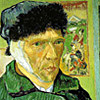Session Overview

|
How are mental disorders diagnosed and treated? This session explores the two main categories of psychological treatment – behavioral therapies and medical (drug) therapies. For OCD, depression and ADHD, we’ll look at the current scientific understanding of these disorders and compare methods of treatment. Keywords: psychotherapy, psychoanalysis, diagnosis, medication, psychopharmacology, CBT, depression, OCD, ADHD, ADD, Ritalin Image: “Self-Portrait with Bandaged Ear,” Vincent Van Gogh (1889). |
Session Activities
Readings
Read the following before watching the lecture video.
- [Sacks] Chapter 11, “Cupid’s Disease” (pp. 102-107)
- Finish the chapter you started for the previous session:
Lecture Videos
View Full Video
View by Chapter
- Treatment Approaches: Behavioral and Medical
- Obsessive Compulsive Disorder (OCD)
- Depression: Diagnosis and Neural Basis
- Depression: Treatments and Studies
- ADHD: Diagnosis
- ADHD: Treatments and Studies
Video Resources
Discussion: Psychopathology
In this discussion, we’ll talk about psychological disorders, or psychopathology. It’s a really interesting question: what kinds of behavior exceed the normal range of behavior for human beings? Which behaviors are truly pathological, as opposed to simply uncommon or exceptional?… Read more »
Further Study
“Extra credit” writing assignment: Is it ethical to use cognition-enhancing drugs?
These optional resources are provided for students that wish to explore this topic more fully.
| TYPE | CONTENT | CONTEXT |
|---|---|---|
| Supplemental videos | The World of Abnormal Psychology. Annenberg Learner, 1992. | 13 1-hour videos on various psychopathology topics |
| Supplemental video | NIMH.gov. “ADHD: Signs, Symptoms, Research.” Sept. 10, 2010. YouTube. Accessed March 9, 2012. http://www.youtube.com/watch?v=IgCL79Jv0lc | Video about ADHD by the U.S. National Institute of Mental Health. |
| Textbook supplement | Study materials for Ch. 15, “Psychological Disorders: Healing Actions, Healing Words.” In Kosslyn & Rosenberg, Psychology in Context, 3/e (Pearson, 2007) | Practice test questions, flashcards, and media for this related textbook |










